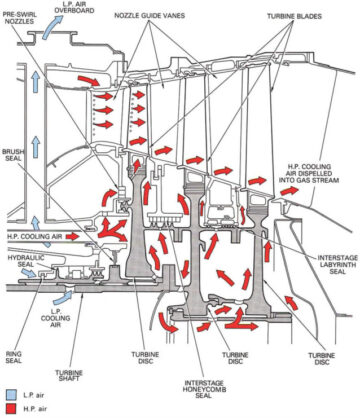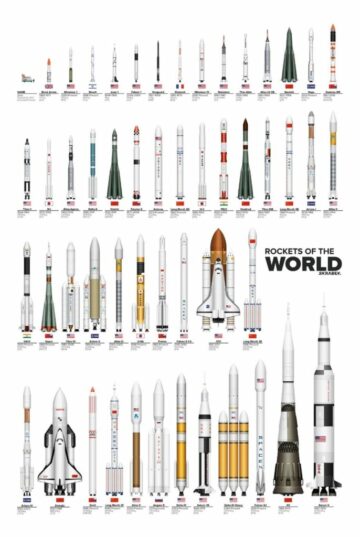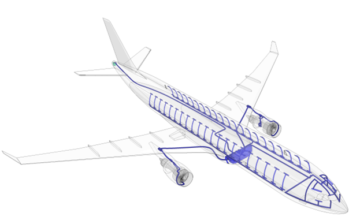Due to concerns about air travel’s impact on climate change, research and development into electric aircraft has been ongoing for several years. Within the last decade several startups as well as larger corporations have been developing electric or hybrid electric aircraft (Ros, 2017). The ultimate goal is to Conduct long (>500 miles), full-electric commercial flights with large aircrafts capable of carrying 100’s of passengers, but this will require at least 5-10 more years of development. Luckily, smaller electric aircraft designed for short-range flights (<500 miles) with anywhere from 1-20 passengers have already been tested successfully utilizing electric batteries, a hybrid-electric system and even a hydrogen fuel cell. With these advances, emission-free air travel is closer than you think.
Electric Aircraft
Examples of full-electric aircraft designs include the Airbus E-Fan 1.0 and E-Fan 1.1 (Airbus Group), shown in Figure 1. These two-person aircraft utilize two ducted, variable-pitch fans, shown in Figure 2. Each fan is powered by a 30-kW electric motor. The motors are powered by several lithium-ion battery packs stored in the wings. While the aircraft only provides an hour of flight time, the batteries can recharge in approximately one hour and can be easily be swapped in and out.


There are several reasons besides climate change why electric aircraft should be developed from a business perspective (Figure 3). Short and mid-range regional flights make up a significant portion of all flights around the world. The current flight range of electric aircraft is limited to these short and mid-range fights. Additionally, shorter flights spend relatively more time taking off and landing than cruising at high altitudes, which makes shorter trips less energy efficient. While short, regional flights are economically unattractive for large commercial aircraft, a smaller aircraft with less fuel consumption may provide a valuable alternative.

One of the main challenges in developing electric aircraft is balancing weight and battery storage. The energy density of jet fuel is more than 40 times greater than that of Li-ion batteries. This means that more weight on the airplane needs to be allocated for its energy supply and fewer passengers and cargo may be transported. Improvements in this energy-to-weight challenge may come from future developments in batteries with better energy density, as well as better energy conversion from stored energy to airplane propulsion and motion. Considering this, when designing an electric aircraft fan, a heavy emphasis should be placed on energy efficiency, since a higher efficiency leads to lower power consumption by the electric motors and potentially a significant drop in the weight required for energy storage.
Hybrid-electric Aircraft
One way to mitigate the weight and flight range issues is to develop a hybrid-electric aircraft such as the Zunum Aero, shown in Figure 4. This 12-passenger aircraft utilizes a hybrid-to-electric powertrain to take passengers on regional flights (up to 700 miles). Its low-pressure, variable pitch fans are powered by electric motors and utilize regenerative braking. The aircraft was designed to allow for the onboarding of new technologies in the future, including potentially a transition to fully electric flight.

Hybrid-electric aircraft may implement designs such as boundary layer ingestion propulsion to operate with reduced drag and fuel consumption, as described in Figure 5. Boundary layer ingestion utilizes propulsors near the back of the aircraft body. The slower boundary layer air flow helps decrease fuel consumption by allowing the engine to work in optimal parameters. Additionally, less drag is generated, leading to better fuel efficiency. One issue with using boundary layer flow is that it is very distorted. Because of this, deswirlers are typically used to straighten the inlet flow. Additionally, the fans need to be more durable to handle the stresses caused by the flow distortion (NASA Glenn Research Center, 2019).

Another design challenge is the aircraft fan and its corresponding electric motor need to be able to draw energy from the batteries much more rapidly during takeoff and landing than it does during cruising. Since the batteries are discharging much more rapidly, they will heat up considerably. Aircraft fans need to strike a balance during these peak operating modes to ensure that the power consumption does not cause extreme battery temperatures or prolonged periods of high energy usage. If this is the case, a cooling system may be implemented for the batteries in order to preserve the lifetime of the batteries, as well as prevent the batteries from catching fire. A quick exchange system may also be implemented in the aircraft’s design, letting depleted or overheated battery packs to be swapped for fresh battery packs and allowing for more time in the air.
Hydrogen Fuel Cell Aircraft
A similar area of energy storage research is the use of fuel cells to electrify aircraft. Companies such as ZeroAvia have developed a hydrogen powertrain to generate a zero-emission electric flight. In September 2020, ZeroAvia conducted a 20-minute test flight for its hydrogen fuel cell powered commercial-grade aircraft. While the gravimetric energy density of hydrogen is three times that of jet fuel, hydrogen requires larger storage tanks to hold the high volume of fuel onboard (McKinsey & Company, 2020). Depending on the weight of the fuel cell and the storage tanks, hydrogen fuel cells may bypass the energy density issue that has been limiting battery-powered electric aircraft design. One limitation to using hydrogen is that airports would need to install new infrastructure such as on-site electrolyzers to generate the hydrogen fuel. If the hydrogen is produced using entirely renewable energy as in Figure 6, zero-emission aviation may be realized.

What this Means for Aviation in the Future
The design considerations for an electric aircraft fan should include many of the design constraints that come with using an electric energy source with low energy density. Since the energy sources are heavier and tend to take up more room on the aircraft, energy efficiency and weight of the fan should be optimized to compensate these shortcomings. While better electric energy sources are currently being designed and developed, their current limitations must be considered. Once better aircraft fans and electric energy sources are developed, longer flights with potentially zero emissions can become a reality.

Do you need help on your next electric propulsion project? Check out the AxSTREAM platform for fan design/analysis, fuel cell system modeling, and more or request a trial here.
- Airbus Group. (n.d.). Airbus E-Fan. Retrieved November 25, 2020, from https://i.insider.com/559fd0116bb3f78978f7425d
- Airbus Group. (n.d.). E-Fan, the New Way to Fly. Airbus Group. Retrieved November 25, 2020, from https://web.archive.org/web/20170418132656/http://www.airbusgroup.com/service/mediacenter/download/?uuid=48b1bd2c-a428-4c65-82e5-ed3e923bd142
- McKinsey & Company. (2020). Hydrogen-powered aviation: A fact-based study of hydrogen technology, economics, and climate impact by 2050. Retrieved from https://www.fch.europa.eu/sites/default/files/FCH%20Docs/20200507_Hydrogen%20Powered%20Aviation%20report_FINAL%20web%20%28ID%208706035%29.pdf
- Nanalyze. (2019, May 1). 8 Electric Airplane Startups Trying to Get Off the Ground. Retrieved from https://www.nanalyze.com/2019/05/electric-airplane-startups/
- NASA. (n.d.). Boundary Layer Ingestion. Retrieved from http://www.design-engineering.com/wp-content/uploads/2017/03/NASA-Boundary-Layer-Ingestion.jpg
- NASA Glenn Research Center. (2019, November 6). Boundary Layer Ingestion Propulsion. Retrieved from https://www1.grc.nasa.gov/aeronautics/bli/
- Ros, M. (2017, November 21). 7 electric aircraft you could be fyling in soon. Retrieved from CNN travel: https://www.cnn.com/travel/article/electric-aircraft/index.html
- Varmin. (2014, June 7). Un réacteur d’airbus E-Fan prise au Meeting de la Ferté-Alais. Retrieved from https://commons.wikimedia.org/wiki/File:Meeting_Fert%C3%A9_Alais-0008.JPG
- ZeroAvia. (n.d.). Retrieved November 2020, from https://www.zeroavia.com/
- Zunum Aero. (2020). Zunum Aero – Technology. Retrieved from https://zunum.aero/technology/
Source: https://blog.softinway.com/considerations-for-electric-aircraft-fan-design/
- air travel
- aircraft
- Airplane
- Airports
- Archive
- AREA
- around
- aviation
- batteries
- battery
- battery storage
- body
- business
- Cargo
- carrying
- Cause
- caused
- challenge
- change
- Climate change
- closer
- CNN
- commercial
- Companies
- company
- consumption
- Conversion
- Corporations
- Current
- Design
- develop
- Development
- Drop
- Economics
- efficiency
- Electric
- electric motor
- emission
- Emissions
- energy
- energy density
- energy efficiency
- exchange
- fights
- Figure
- Fire
- flight
- Flights
- flow
- fresh
- Fuel
- fuel efficiency
- future
- Group
- here
- High
- hold
- HTTPS
- Hybrid
- hydrogen
- Impact
- Including
- Infrastructure
- Insider
- issues
- IT
- large
- leading
- Limited
- Long
- modeling
- Nasa
- Near
- Onboarding
- operating
- order
- perspective
- platform
- power
- Produced
- project
- range
- Reality
- reasons
- Recharge
- renewable energy
- research
- research and development
- Short
- spend
- Startups
- storage
- Study
- supply
- system
- Technologies
- Technology
- test
- The Future
- time
- transported
- travel
- trial
- UN
- volume
- within
- Work
- world
- years
- zero








